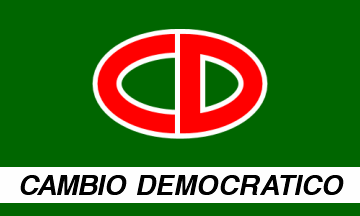
image by Eugene Ipavec, 7 October 2010

Last modified: 2020-04-18 by rob raeside
Keywords: panama |
Links: FOTW homepage |
search |
disclaimer and copyright |
write us |
mirrors
Registered Political parties:
Unregistered Political parties and movements:
See also:

image by Eugene Ipavec, 7 October 2010
The party "Cambio Democrático" was registered with
the Electoral Court of Panamá on 20 May 1998 (Resolution 101).
It is currently chaired by its founder Ricardo Martinelli and
currently an opposition party. The emblem and flag of the party
are described in the party statutes as follows (my translation
from Spanish):
Article 5. The distinctive emblem of the party is made of an
horizontal turquoise green oval, this colour symbolizing the hope
of better days for Panamá, on which are placed the magenta
letters CD outlined in white, acronym of the party name,
representing the transparency of the acts of the party.
Article 6. The flag of the party is a rectangle divided into two
horizontal stripes, one turquoise green covering 5/6 of the total
flag area, with in its center a big symbol of the party, the
other white covering 1/6 of the total flag area, charged with the
name of the party CAMBIO DEMOCRATICO in magenta letters shadowed
turquoise green.
Source: www.tribunal-electoral.gob.pa
The image shown on www.tribunal-electoral.gob.pa
(located by Dov Gutterman, 8 August 2002) seems to
indicate that the proportion of the flag is 3:5. I have attempted
to reconstruct the flag but the details are not accurate, namely
the geometry of the emblem and the colours of the letters, which
I have left black by defualt. I have not been able to locate an
image of the real flag.
Ivan Sache, 7 October 2006
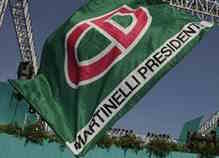
located by Eugene Ipavec, 7 October 2010
Several flag images were shown in a Yahoo News slideshow of
interrelated photos. The colors and details are slightly different.
There was also a variant reading "MARTINELLI PRESIDENTE,"
referring to founder Ricardo Martinelli, in lieu of the party name.
Eugene Ipavec, 7 October 2010
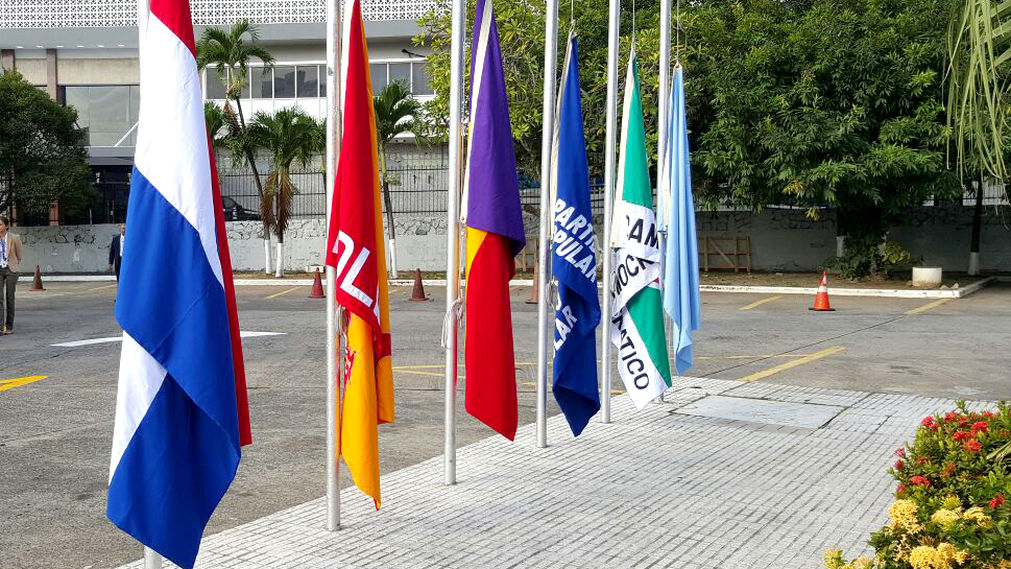
image located by Esteban Rivera, 14 March 2016
In this picture one can see a sky blue flag at the end of the row of a total six
flags. If the National Assembly currently has five political parties, does anybody know the sky blue flag at the
end of the above mentioned picture, to what party does it belong to, or what it stands for?
The same flag can be seen: Source here (image here) - First flag from left to right). On the electoral ballot (source here) for Presidential Elections of 2014 we can see that candidate number 7 is labeled as Libre postulación (Independent) and has the sky blue color assigned, and that other independent candidates (#8 and #9) also have a color to be distinguished from the other candidates, but that is no official movement nor political party.
Is this common practice to denote an independent candidate with a color and issue a flag, or that is just mere coincidence?
Esteban Rivera, 14 March 2016
I think I remember reading somewhere that the Electoral Tribunal (TE) of Panama represents independent, or free applicant candidates (Libre Postulación), who are running in an election by using a plain undecorated flag like that sky blue one. I'd guess for other independent candidates they'd use other colors. If I'm not mistaken they had three independent candidates running in the last general election for President (Esteban RodrÃÂguez, Juan Jované and Gerardo Barroso) and perhaps they were assigned the same color? Hopefully somebody can verify this (only an "educated guess" or hypothesis, right now) for us.
Pete Loeser, 18 March 2016
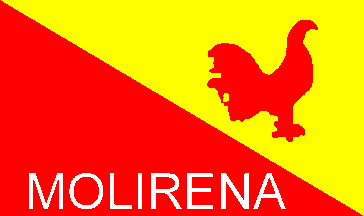
image by Ivan Sarajcic, 26 December 1999
Molinera is one of the parties that combines the
"El-Cambio".
Dov Gutterman , 25 December 1999
MOLIRENA means "MOvimiento LIberal REpublicano
NAcionalista". The party, chaired by Gisela Chung, was
registered with the Electoral Court of Panamá on 12 August 1982
(Resolution 648). It it the third biggest party
in Panamá by its membership (80,905 on 31 august
2006), but far behind the PRD (462,205) and the
Partido Panameñista (187,636).
The symbols of the party are described in the party
statutes as follows (my translation from Spanish):
Article 2. The symbol or emblem of the party is made of a
rectangular flag divided into two equal triangles whose bases
form a diagonal running from the upper left to the lower right
corner of the flag. The triangle adjacent to the hoist is red
with the acronym MOLIRENA in white letters, whereas the distant
triangle is yellow with a red rooster.
The flag of the MOLIRENA can be seen in real on photographies at www.pa-digital.com.pa
and mensual.prensa.com.
Ivan Sache, 7 October 2006

image by
Jaume Ollé, 29 December 2013
The MORENA (Movimiento de Restauracion Nacional) is no longer
in activity. Along with the Partido Arnulfista,
the MOLIRENA and Cambio
Democrático, it was part of the coalition Unión por Panamá
led by Mireya Moscoso, who won the presidential election in 1999.
The MORENA had one representative elected in the Legislative
Assembly for the period 1999-2004.
The flag is horizontally divided green-yellow, with a green map
of Panamá allover, the acronym of the party in big yellow
letters above the map and its full name in smaller black letters
below the map. My approximate rendition based on small image of the flag from
www.sinfo.net/molirena/mireya2.gif (defunct), located by Dov
Gutterman, 27 December 1999, is above.
Ivan Sache, 7 October 2006
The word morena is Spanish for "Moray eel".
António Martins-Tuválkin, 9 October 2006
While image is based in a very small image, I created a better, correct image.
Jaume Ollé, 29 December 2013

image from www.tribunal-electoral.gob.pa,
located by Dov Gutterman
The political movement Movimiento Papa Egoró (Mother Earth in
the indigenous language) was founded in the 1990s by Rubén
Blades (b. 1948), the internationally famous salsa musician and
actor. Blades was a a pioneer in the Nueva Cancion (New Song)
movement, recording his first album in 1966. The movement was
registered as a political party with the Electoral Court of
Panamá on 19 January 1993 (Resolution 9). In 1994,
Blades ran for President of Panama and finished in third place,
with about 20% of the vote.
In 1999, he announced that Papa Egoró would support Martin
Torrijos, the candidated of the PRD, which caused a great fuss
and the disbanding of the movement. Blades was appointed as
Panama's Minister of Tourism by President Torrijos in 2004-2009.
The flag of the party, as seen waved by Blades on a photo, is
made of the party emblem surrounded by a narrow white border.
Ivan Sache, 13 September 2009
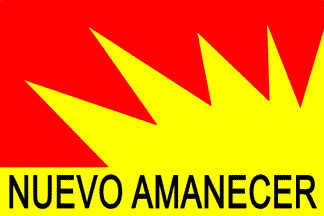 image by Andy Weir, 11 January 2001
image by Andy Weir, 11 January 2001
Based on umage from www.martinpresidente.com/partidos.html
(defunct).
Dov Gutterman, 27 December 1999
"Nuevo Amanecer" means New Dawn in Spanish, which
might explain the rising sun of the flag.
Ivan Sache, 8 October 2008
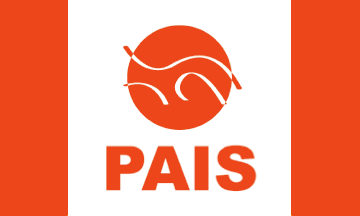 image by Ivan Sache, 7 June 2019
image by Ivan Sache, 7 June 2019
The Partido Alternativa Independiente Social (PAIS) organized its
constitutive convention on 19 August 2018. Derived from a collective presided by
the lawyer José Alberto Álvarez, PAIS is a conservative party with supports
family and rejects same-sex marriage. Among his leaders are two evangelic
pastors, Orlando Quintero (Vice President) and Horacio Freeman (Secretary
General).
The flag of PAIS is white with two vertical orange stripes on
the edges and the party's emblem and acronym, all orange.
http://www.destino2019.com/pais-realizara-su-convencion-constitutiva-el-19-de-agosto/
Destino 2019, 26 July 2018
PAIS was probably not validated as a
political party by the Electoral Supreme Court since it did not compete in the
general elections held in May 2019.
Ivan Sache, 7 June 2019
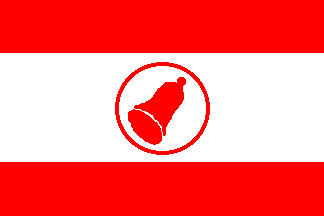 image by Ivan Sache, 7 October 2006
image by Ivan Sache, 7 October 2006
The party flag is a bell in a circle on Austrian
type bedsheet as seen at www.tribunal-electoral.gob.pa.
The "Partido Liberal" is currently ran by Joaquin R.
Franco Vasquez and supports the government of Panamá. It was
registered with the Electoral Court of Panamá on 4 March 2005
(Resolution 30), but dates back to much older times, when Panamá
was united with Colombia (until 1903). The colour of the Liberal
Party is red; the red fields of the national flag of Panamá
represent the (then) Liberals (but the current follower of those
early Liberals seems to be the Partido Liberal Nacional rather
than the Partido Liberal).
The symbols of the Partido Liberal are described in the party
statutes as follows (my translation from Spanish):
Article 2. The distinctive symbol of the Partido Liberal is a
flag of rectangular shape divided in three rectangular fields.
The upper and lower fields are red and cover each one quarter of
the flag; the middle field is white and is charged in the middle
of a red ring surrounding a red bell. The shield of the Partido
Liberal is a bell ringing the victory, placed within a white
cricle surrounded by concentric red lines. The name of the party
PARTIDO LIBERAL is placed above the bell; below the bell is the
motto DEMOCRACIA, JUSTICIA Y LIBERTAD.
Moreover, Article 17 l prescribes that modifications of the party
symbols can be made only by the National Convention of the party.
Ivan Sache, 7 October 2006
alleged flag of the party
image by Jaume Ollé, 6 October 2006
Plain red flag appeared at
www.martinpresidente.com/partidos.html (defunct).
Dov Gutterman, 27 December 1999
The Partido Liberal Nacional is chaired by Anibal Galindo. It
was registered with the Electoral Court of Panamá on 29 October
1997 (Resolution 279), but it traces back to the old Partido
Liberal of the Columbian era (before the secession of Panamá and
its independence, 1903).
The symbols of the PLN are described in the party
statutes as follows (my translation from Spanish):
Article 2. The symbol of the party is described as follows: it is
a red rectangular flag, waving in the wind with a single wave,
with a black staff surmonted by a lance arrow, placed on a white
background charged in its lower part with the name of the party.
The dimensions will be listed in an official presentation. The
shade of red is described as follows: a bright red shade, equal
to the shade of the red quarters in the national flag, which
represents liberalism since the foundation of the Republic.
(Article amended on 16 October 1997 during the second ordinary
meeting of the party board).
Therefore, there is no party flag prescribed in the statutes and
there is no hint that a plain red flag is used by the party.
Ivan Sache, 7 October 2006
See also: Unión Patriótica

image from www.tribunal-electoral.gob.pa
PNP stands for Partido Nacionalista Popular and was
registered by resolution 2 of 12 January 2004 Flag is orange with
white emblem (consist of book, cogwheel and another object) and
black party initials.
Dov Gutterman, 6 November 2006
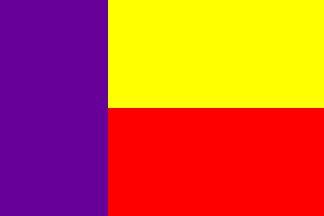
image by Phil Nelson, 25 December 1999
The flag of Arnulfista (part of El-Cambio) is horizontal
yellow on red with a blue hoist vertical bar as seen at
www.mireyaeselcambio.com/menu.htm (defunct)
Dov Gutterman, 25 December 1999
Image shows purple hoist with yellow over red. Based upon
size, it appears to follow the 2:3 pattern of the Panamanian
national flag. Representation: fair.
Phil Nelson, 25 December 1999
Arnulfist Party: flag formed by a vertical band at the hoist,
in blue, and two horizontal stripes at the fly, yellow (the
upper) and red (the lower).
The Arnulfist Party takes its name from the conservative
politician Arnulfo Arias, and it is considered close to the
American positions, and to conservative politics.
Jaume Ollé, 27 March 2005
On 10 August 2005, the Electoral Court of Panamá accepted the
change of the name of the "Partido Arnulfista" to
"Partido Panameñista" (Resolution 70). The name of
the "Partido Arnulfista", founded in 1990,
refers to Arnulfo Arias (1901-1988), President of the Republic of
Panamá in 1940-1941, 1959 and 1968, each time expelled by a
military coup. His widow Mireya Moscoso (b. 1946), representing
the "Partido Arnulfista", was President of the Republic
in 1999-2004. The "Partido Panameñista" is currently
chaired by Juan Carlos Varela. It is now the prinicipal
opposition party in Panamá.
The "Partido Panameñista" has kept the flag of the
"Partido Arnulfista", described in the party statutes
as follows (my translation from Spanish):
Article 3. The flag of the "Partido Panameñista" is a
rectangle or a wavy rectangle, with proportion 2:3 and three
rectangular fields of equal area. The left field, stretching over
one-third of the total area of the flag is placed vertically and
of colour "morado", which means for the Panameñists
the past, present and future sacrifices and their fight for a
better Panamá. The two other fields on the right part of the
rectangle are horizontal; the upper field is yellow, meaning the
intuitive hope of men, women and children in the advent of a new
ear of enlightment, Fraternity, Peace and Abundance; the lower
field is red, which for the Panameñists means the blood shed by
our martyres in all times for the sake of our fight for Justice,
Independence and Democracy.
Article 4. The symbols and emblems of the "Partido
Panameñista" are: a. The flag of the "Party
Pañamenista", as described in the previous Article. b. The
flag and emblems representative of the historical periods where
Dr. Arnulfo Arias Madrid' Panameñism acted as a political
entity. They are described in Appendix A to this
statutes.
Source: www.tribunal-electoral.gob.pa.
Ivan Sache, 7 October 2006
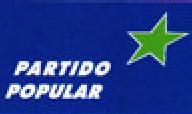
image from www.tribunal-electoral.gob.pa,
located by Dov Gutterman, 8 August 2002
Partido Popular was registered by resolution 365 of 28 August
1980 as Partido Demócrata Cristiano (PDC) and changed its name
according to resolution 251 of 10 September 2001. The change in
name also brought to change of the flag.
PDC flag was a green star leaning to the
fly on white bedsheet with party initials above the star's hoist arm as seen at www.tribunal-electoral.gob.pa.
The Partido Popular flag is described in its statutes
as:
"ARTÍCULO 2: El símbolo distintivo de El Partido
consiste en una bandera rectangular de color azul en la que
figuran una estrella de color verde en movimiento hacia delante
enmarcada con ribete blanco y el nombre PARTIDO POPULAR en letras
gruesas, también de color blanco.
La estrella verde simboliza los valores del humanismo cristiano o
integral, la esperanza de un mundo mejor y la trayectoria
histórica de El Partido; el azul, la unidad de las corrientes de
pensamiento democrático, pluralista e integrador que lo
constituyen y, el blanco, la paz, la armonía y el patriotismo
civilista que lo inspiran".
Dov Gutterman, 6 November 2005
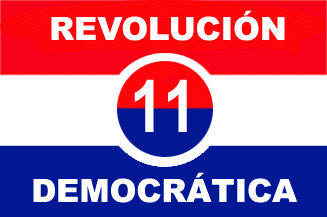
image by Jaume Ollé, 27 March 2005
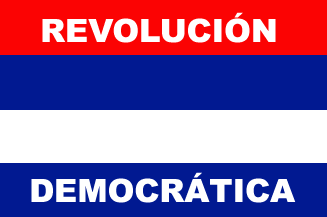
image by Jaume Ollé, 27 March 2005
Party of the Democratic Revolution (of Ernesto Perez
Balladares): flag of three horizontal stripes, the upper red, the
central white, and the lower dark blue. In the center a
two-colored disk, red over dark blue, with a white border al
around the disk. Within the red-blue colors is the number 11 in
white. In the red upper band is written in white the word
REVOLUCIÓN. In the lower blue band the word DEMOCRATICA.
The Party of the Democratic Revolution stemmed from the
nationalist and progressive options adopted by General Torrijos,
who obtained the retrocession of the Channel Zone, administered
by the United States, to Panama. It has directed the political
life in the last years, with exception of the lapse of the
American invasion and the establishment of a government favorable
to the interests of the United States Supposed variant of
the same Party flag observed in television images: Flag of four
horizontal stripes, the upper red, the following dark blue, the
third white and the lower dark blue. It also contains the words
REVOLUCIÓN (written in white in the upper band) and DEMOCRATICA
(written in white in the lower band).
Jaume Ollé, 27 March 2005
See also: www.prd.com.pa

image from www.tribunal-electoral.gob.pa
Partido Renovación Civilista and was registered by resolution
348 of 23 November 1993. Flag is white and charged with ab hand
holding a dark blue-light blue torch.
Dov Gutterman, 6 November 2006
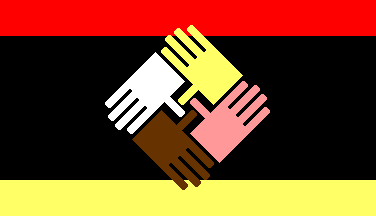
image by António Martins, 23 March 2000
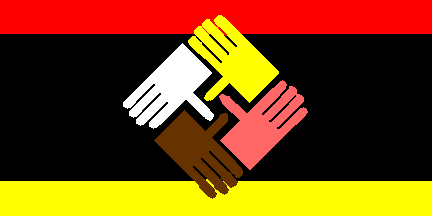
1:2 version
imageby Ivan Sache, 26 December 1999
These four hands supposedly stand for inter-racial solidarity
and fellowship, OK. But who's who? Brown should be for anfrican
panamians, thats clear. But what about the others?
António Martins, 23 March 2000
I suspect that the hands stand for (by generally accepted
continent of origin)
White - Europeans
Red - Americans
Yellow - Asians
Black - Africans
It is reminiscent of lyrics from the children's song:
"Red and Yellow Black and White,
They are precious in His site,
Jesus loves the little children
of the world"
Nathan Bliss, 24 March 2000
Just a guess, but may I suggest brown for African, yellow for
Asian (Chinese), rose (red) for Native Indian, and white for
European?
Joe McMillan, 25 March 2000
See also: Unión Patriótica
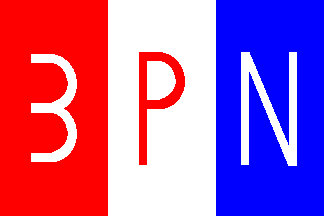
image by Ivan Sache, 6 August 1999
Nationalist Party - Vertical red-white-blue with a white
"mirrored" 3 in red stripe, a red P in white stripe and
a white N in blue stripe.
Source: Smith (1975), pp. 340-341 ("Symbols in
politics").
Ivan Sache, 6 August 1999
The 3PN stands for "Tercer Partido Nacionalista"
(3rd Nationalist Party) - one of the government coalition parties
that lost the 1968 elections won by the Panamenista party.
11 days after the Panamenista president was inaugurated, Torrijos
overthrew him.
At the time of SmithÂ's book (1975) all political parties
including the 3PN were banned by Torrijos and no unique official
party existed. Torrijos formed the PRD party in 1979 also
allowing all other parties.
The 3PN joined the Republican and one of the Liberal parties to
form the opposition MOLIRENA.
Alvaro Aguilar, 21 December 1999
The new political party "Unión Patriótica" (UP),
the result of the merging of "Liberal
Nacional" (PLN) and "Solidaridad",
was registered on 8 August 2006 with the Election Court of
Panamá by the respective leaders of the two former parties,
Aníbal Galindo and José Mulino. The merging was approved by
"Solidaridad" on 16 July and by PLN on 23 July.
Source: La
Prensa, Panamá, 8 August 2006.
The new political party will be chaired jointly by the leaders of
the two former parties during a transition period. The party has
a flag, statutes and a government plan.
Source: Panactual.com,
6 October 2006.
Ivan Sache, 6 October 2006
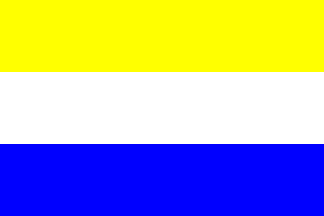
official flag of the VMP
image by Ivan Sache, 7 October 2006
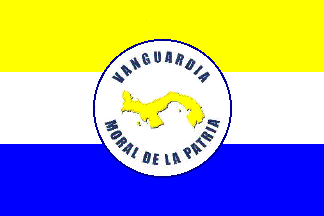
flag of the VMP with the party emblem
image by Ivan Sache, 7 October 2006
According to a morning's newspaper in Panama, one of their
Political Parties has a new flag. The flag is Yellow, White and
Blue, in horizontal form, and the name of the party is Vanguardia
Moral de la Patria (meaning: at the Front of the Fatherland's
Moral Values).
Javier Blake, 26 July 2004
The VMP is still "in the process of formation",
according to the Election
Court of Panamá. Its founder is Guillermo Endara Galimany,
former President of the Republic of Panamá (1989-1994), an
opponent to current President of the Republic Martín Torrijos.
Endara called for voting "no" to the referendum on the
increase of the Canal of Panamá, scheduled to 22 0ctober 2006,
claiming that the project is unconstitutional. In the 1990s,
Endara contributed to the restructuration of the "Partido
Arnulfisto" and was recently expelled from the party after
having denounced its corruption.
The VMP blog
shows the flag of the party as horizontally divided
yellow-white-blue. From the party statutes (see below), it seems
that this flag is the official one and that local branches of the
party are allowed to deface it with the emblem of the party and,
when required, the branch name.
"La
Prensa", 24 June 2006, shows a photography of the
meeting during which the name of the party was adopted. Two flags
are shown, one without the party emblem and one with it.
The flag of the VMP is described in the party
statutes as follows (my translation from the original in
Spanish, with my comments placed between square brackets):
"Article 2. The symbols of the party are:
1. The flag, rectangular and divided into three equal horizontal
stripes, made of three colours: the upper stripe, yellow, the
central stripe, white, and the lower stripe, blue. Meaning of the
colours of the party flag: Blue: Involvment and empowerment in
the fight for building a better country, providing peace,
progress and prosperity to all the Panamanians. White: Honesty,
justice, equality, democracy and liberty. Yellow: Faith and
confidence of the Panamanians in a promising future for the
country.
EXPLANATORY NOTE. The branches at the national, provincial,
municipal and district level can use a single copy of the flag,
rectangular and divided into three equal horizontal stripes, made
of three colours: the upper stripe, yellow, the central stripe,
white, and the lower stripe, blue. In the center of the flag, on
the white stripe and overlapping the upper yellow and the lower
blue stripes, shall be placed a shield (logotype or emblem),
circular with a white background, with the writing VANGUARDIA
MORAL DE LA PATRIA in blue letters in an arched pattern, the
representation of the isthm of the Republic of Panamá, in yellow
with a blue outline. The blue stripe shall be charged with the
name of the region or the geographic entity [colour not
mentioned].
2. The shield, logotype or emblem, circular with a white
background and a blue border, with the writing VANGUARDIA MORAL
DE LA PATRIA in blue letters in an arched pattern, the
representation of the isthm of the Republic of Panamá, in yellow
with a blue outline.
3. The anthem. For propaganda purpose may be used a logotype with
the acronym VMP in blue letters or yellow, place over the
representation of the isthm of the Republic of Panamá in the
middle, in yellow with a blue outline. [The latter paragraph
seems to me misplaced and might be better placed at the end of
section 2.] Article 3. [The first section of Article 3
starts with the list of the movements historically related to the
party.] For official purposes and in official advertizing
campaigns [I guess for elections], the party shall use only and
exclusively the flag described in the first section of this
article. [Again, this paragraph seems to be misplaced.] However,
for advertizing campaigns, the party may use and show various
logotypes with the party acronym, provided the distinctive
colours of the party are always present".
The handbook
of the party's member repeats the descriptions of the emblems
from the party statutes, with images of the flag and the emblem,
which are not shown in the statutes. It gives the main parts of
the party anthem, mentioning the party flag as "Nuestra
enseña, emblem de paz" (Our flag, symbol of peace).
Ivan Sache, 7 October 2006
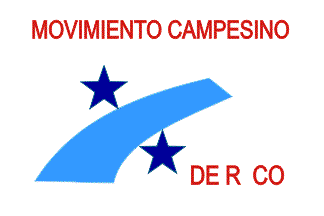
image by Jaume Ollé, 27 July 2005
The MOCAMDERCO is a local movement protesting against the
waste of the hydraulic resources of Río Cobre. Río Cobre is the
biggest river in central Panamá (province of Veraguas). The
MOCAMDERCO fight against a project of hydro-electric power plant
ran by the company "Hidroeléctrica Estrechos S.A.",
which would ruin the environment of Río Cobre and despoil the
local inhabitants of their main natural resource. The endangered
zone is called "Los Estrechos del Río Cobre". The
MOCAMDERCO organized its first public demonstration on 18 June
2003 in Puente del Río Cobre. Photographes at Caritas
Panamá website taken during this demonstration show a flag
similar to the one shown above.
Photographies taken during another demonstration on the same
place on 12 October 2003 shows a different flag: the
blue representation of the river is bigger, there are three stars
instead of two and the lettering is different (MOCAM instead of
MOVIMIENTO CAMPESINO on the top of the flag).
This very same flag seems to have been used during a
demonstration held in Panamá city on 20 January 2004as seen at MOCAMDERCO website.
Ivan Sache, 7 October 2006